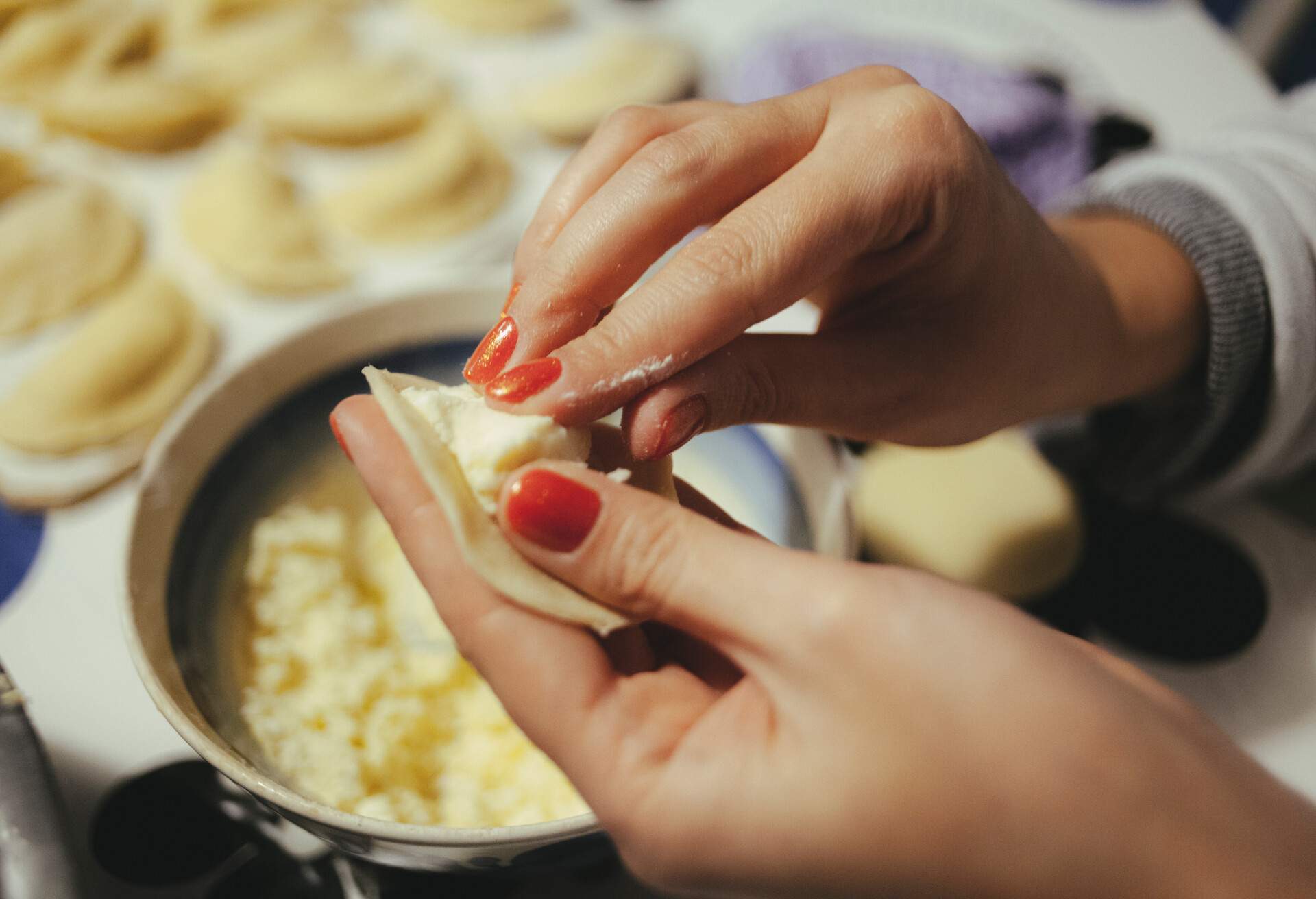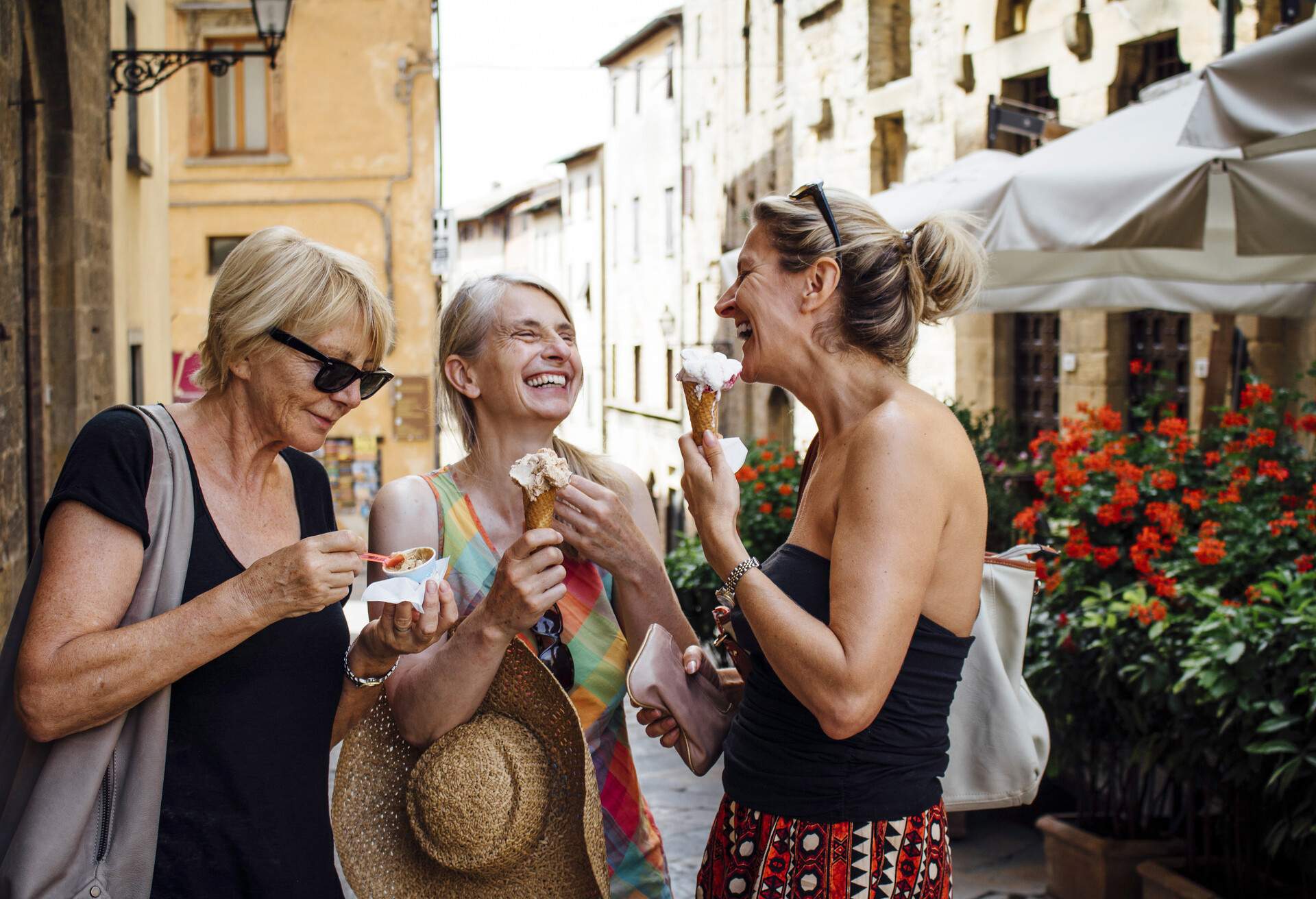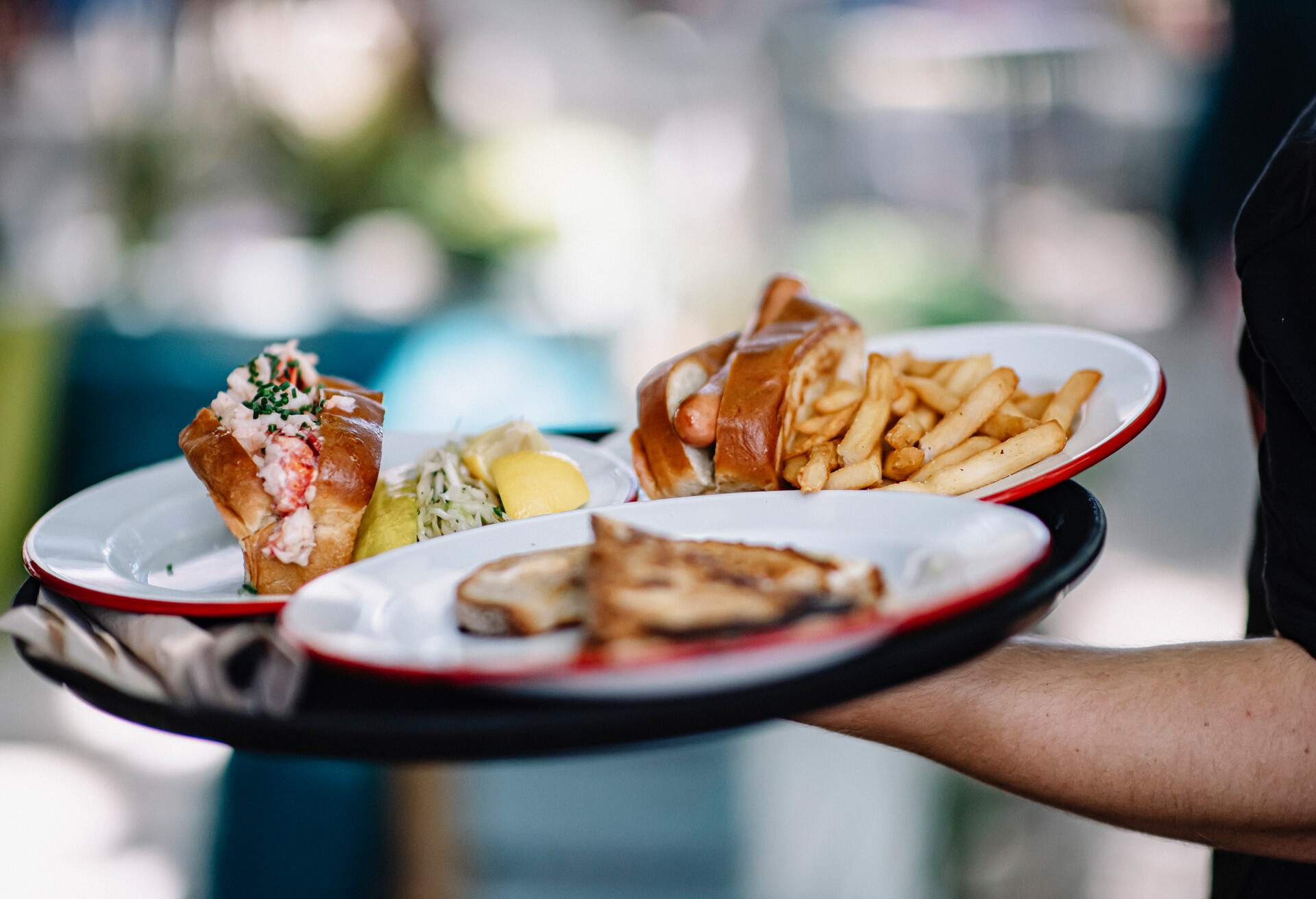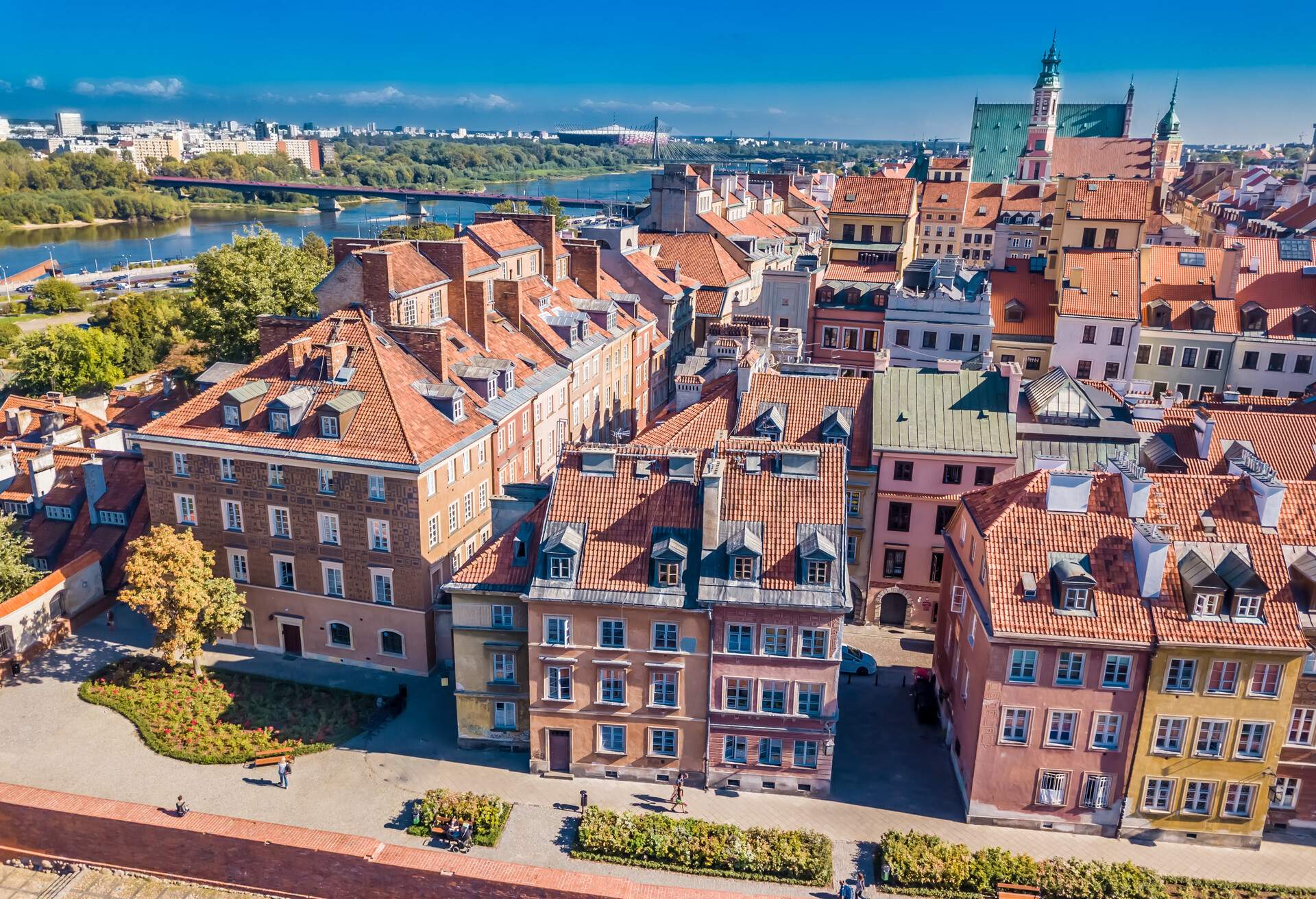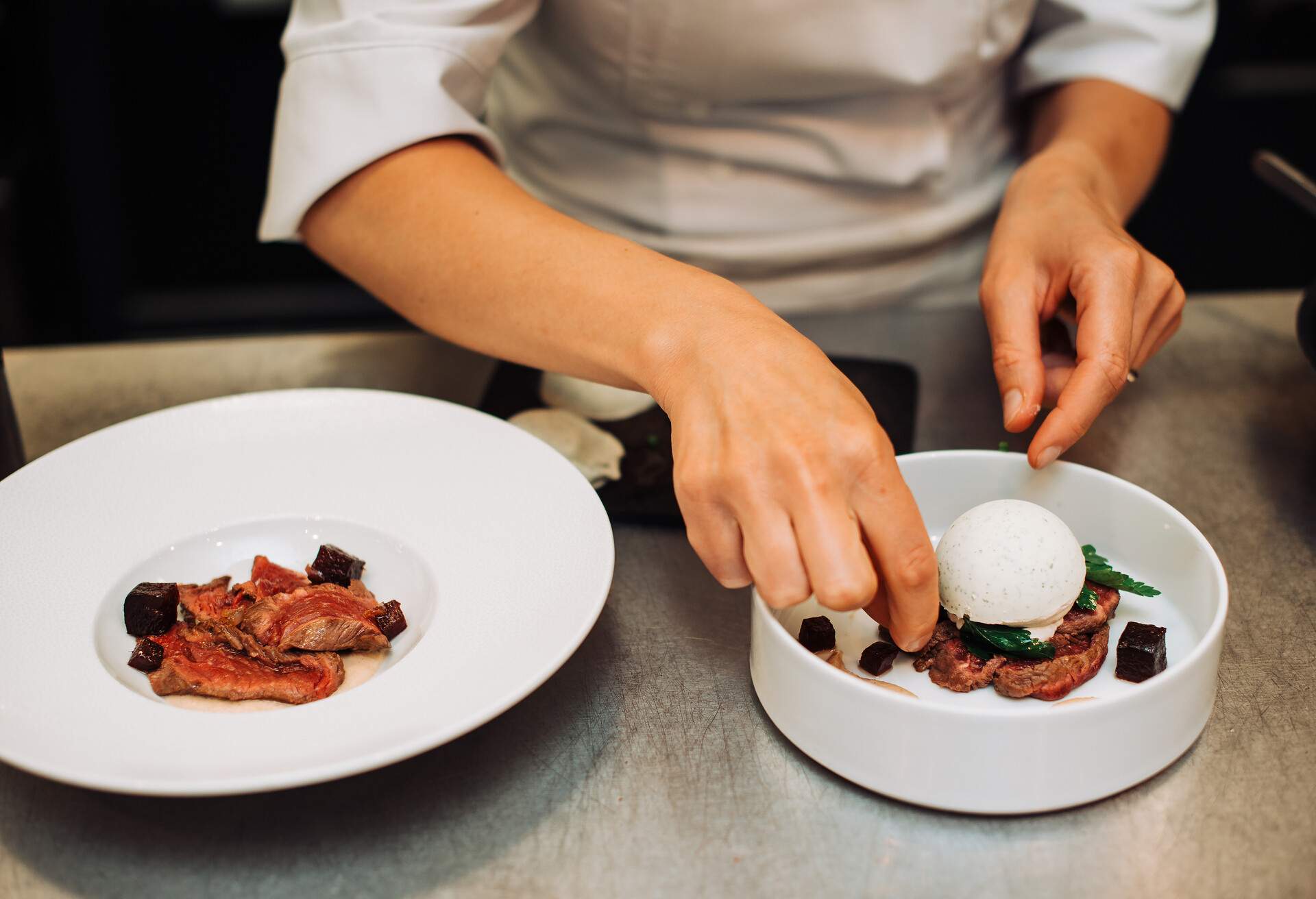Food is one of the best ways by which to travel and explore a foreign country. Yes, we live in a world where the cuisine has travelled, but nothing beats tasting food in its country or place of origin. A place where the natural ingredients are left to shine, where such foods tell stories of customs and traditions passed down generations through recipes. It can often be a door into centuries of history, highlighting a way of life that may otherwise be overlooked in a different country; there’s no direct connection. Thus it is with traditional Polish food.
Traditional Polish food
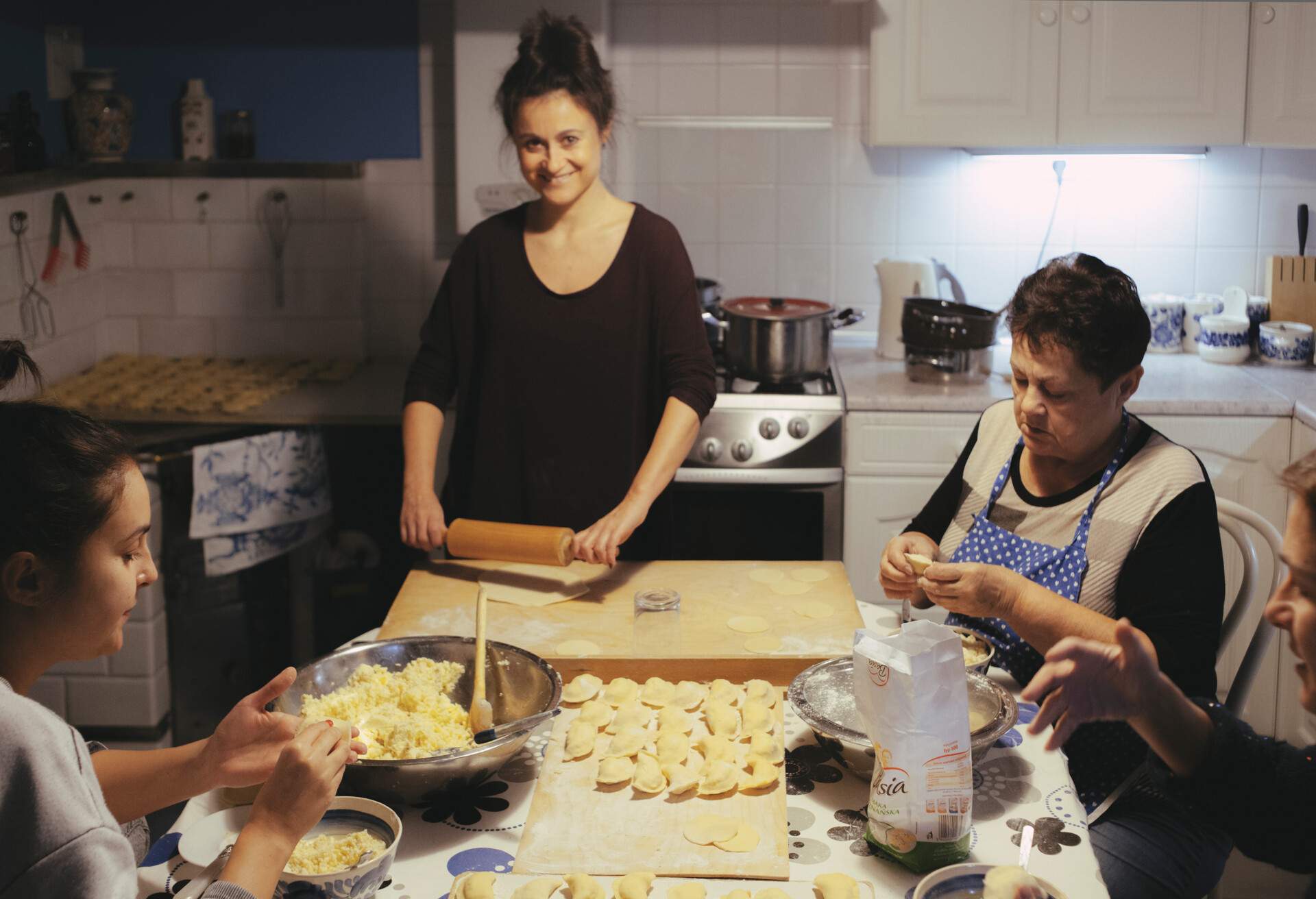
Influenced by cuisines from many of its neighbours, Polish food is hearty, bold, generous and utterly delicious. At the core of traditional Polish food are dishes with humble beginnings that champion sustainability, something many chefs around the world are trying to emulate now. You will often find all parts of an animal used up in cooking, as with the dish flaki. When times were tough, they adapted with fantastic results; placki ziemniaczane is a good example. These are just a few of the must-try dishes.
Some of the best places to appreciate the Polish food and drink culture are its milk bars, which are roadside cafes found everywhere in Poland. Here, along with Poland’s national food, the choice of drink will either be kompot, an unsweetened mixed berry juice that can be served cold or hot, or kefir, a soured milky culture that has set the world of healthy gut enthusiasts on fire.
Zurek
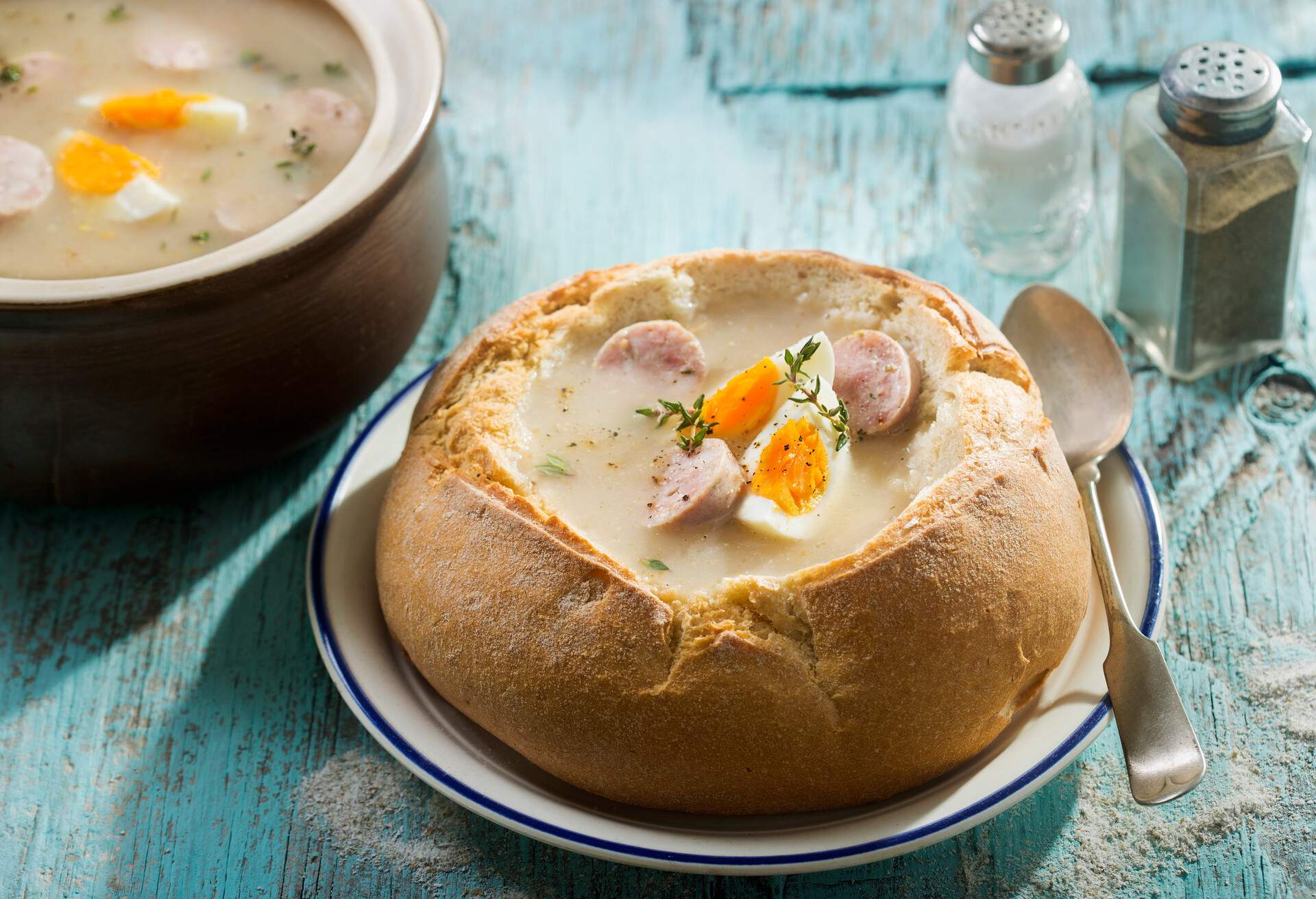
With humble origins and a unique flavour, zurek could easily be termed the national food of Poland. A soup that’s mainly eaten at Easter, it’s both earthy, due to the use of fermented rye, and creamy. You will often find regional variations of it, with families putting their personal stamp on the dish. But the base ingredients in all of them are rye, potatoes, vegetables, bacon and a speciality Polish sausage that’s white, with a touch of marjoram. It’s then served with a boiled egg. If you come across chlebie on a menu, it is the same soup; it just means that you’ll be getting yours in bread instead of a bowl.
Origins of the dish vary but all theories are humble in nature. Some versions say it started with farmers not cleaning out their pots before cooking the next meal, hence the fermentation. Others state it stemmed from villagers challenging a miserly baker who used to serve everything at his inn watered down. Whatever the origins, this hearty soup is warming on a cold winter’s day in Poland. If you’re in the southern parts of the county, Smakolyki is just the place to warm yourself up with this hearty soup. Located within most of the local attractions in Krakow, the restaurant has great views, is cosy and friendly but most importantly is known for its generous portions.
Pierogi
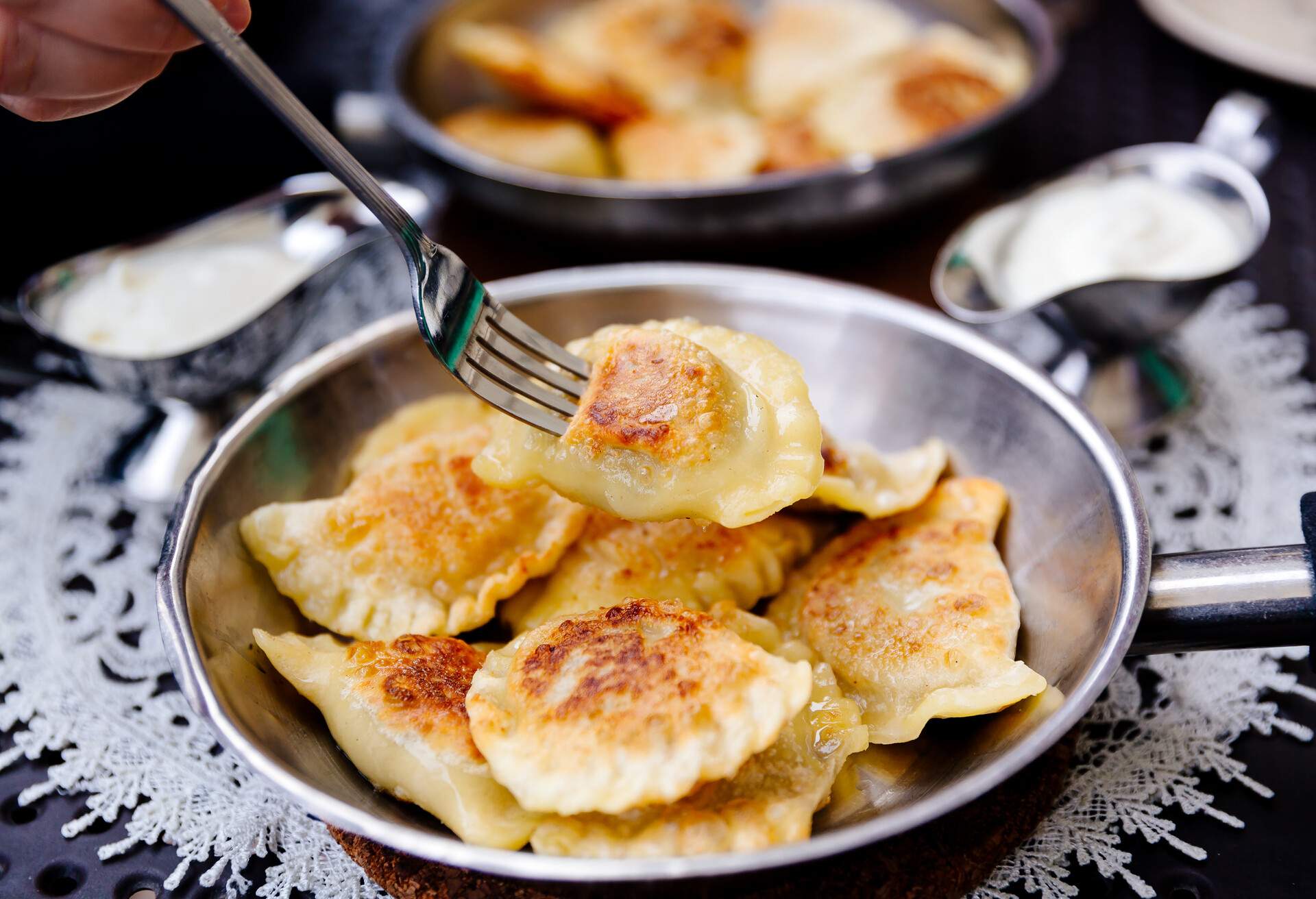
Pierogi is easily the most popular Polish food; it’s a stuffed dumpling with fillings of either meat or vegetables. Common is sauerkraut (a pickled cabbage loved in Poland), spinach, mushrooms, potatoes or fried onions, amongst others. These are filled into a thin pastry before either frying or boiling. Traditionally, they would be boiled and then served with butter and fried onion on top, but fried versions have become more and more popular. They can also be eaten as a desert with interesting fillings like berries or raisins with sweet cottage cheese and even chocolate.
As with many foods passed down through generations, the origins of this famous Polish food are varied and murky. Two versions both link it to Saint Hyacinth, who with prayer after a storm managed to restore crops that had withered, and as gratitude villagers made them for her. Other versions say she fed villagers with the dish after an attack from Tartans that had led to famine. The more plausible version could be that which follows Marco Polo on his expeditions on the Silk Road, given that dumplings have a strong connection with China. Originally considered peasant food, they became widely spread in the 17th century and have since become a much-loved food with various versions served on different occasions. Poland’s milk bars are the best place to try them. In Warsaw, head to the trendy Prasowy near the Old Town.
Golabki
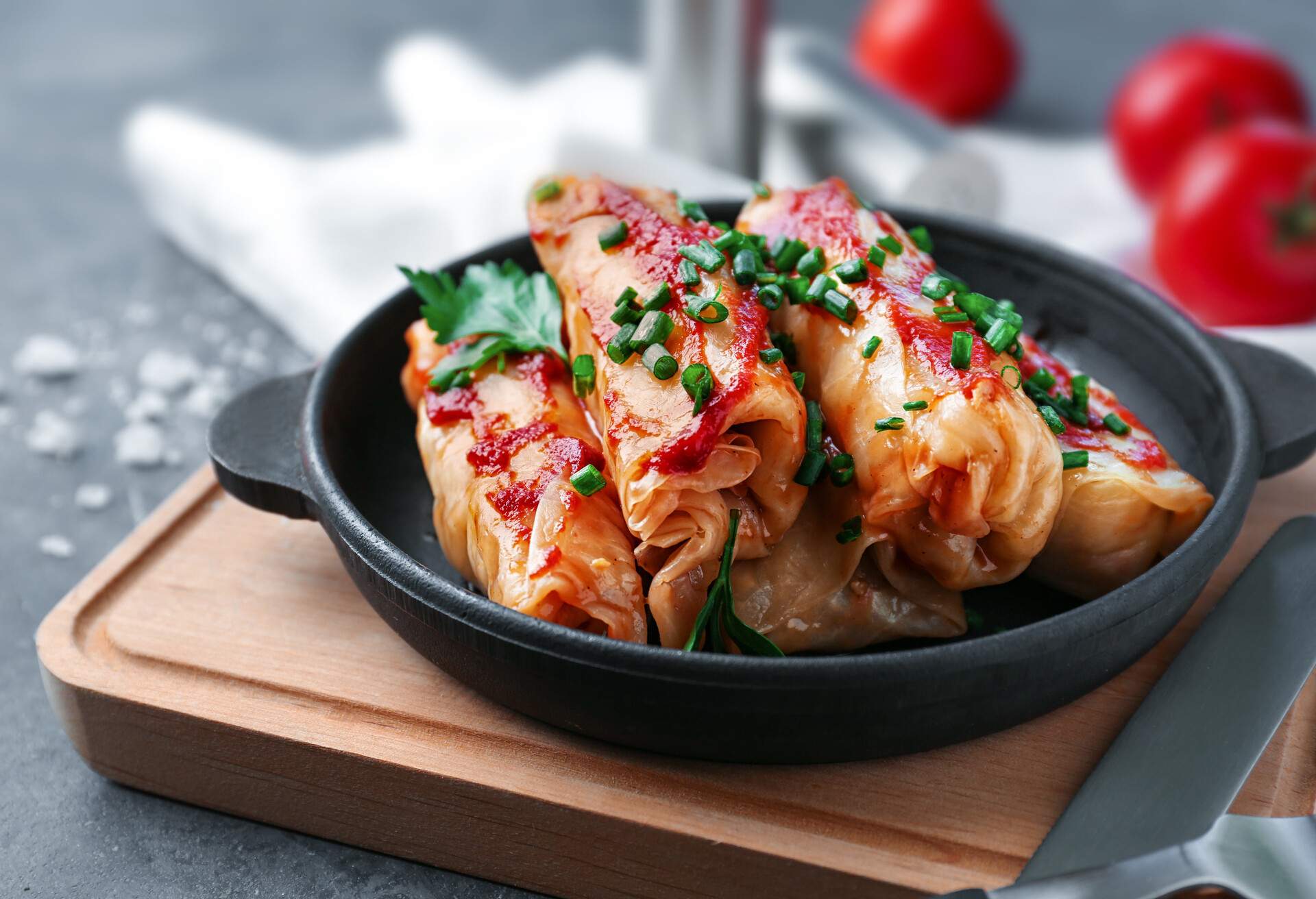
You could say golabki is a typical Polish food that may have spread around the world given its basic ingredients: cabbage filled with either minced beef or pork (or a mixture of the two), onions and rice. It’s then folded into cigar-like rolls before boiling. After this, they are served with either bread or boiled potatoes with a creamy tomato sauce; nothing screams winter comfort food more than this version. In the lighter spring or summer months, they will typically be filled or served with spring vegetables.
The name, translating to little pigeons, may have come from an Aristocratic dish served at feasts in the Ukraine, holubtsi, which is a stuffed pigeon wrapped in cabbage. It’s thought to have then found its way into Poland in the 19th century and became ingrained in the Polish culture’s food. Stuffings change depending on region and, of course, season.
Kotlet Schabowy
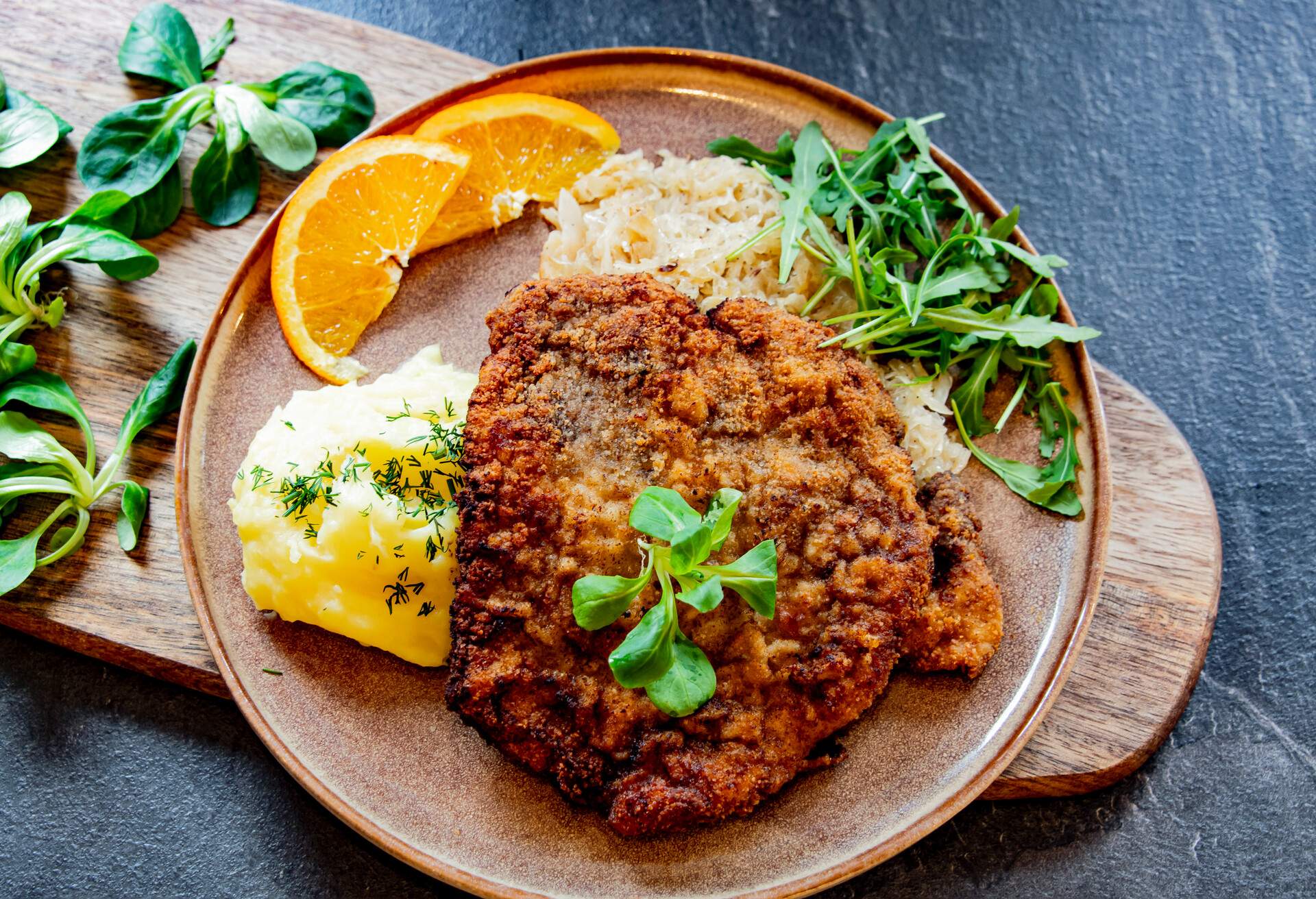
Whilst the Viennese have the Vienna schnitzel, the Polish have the kotlet schabowy, often referred to just as schabowy. Made in very much the same way as the schnitzel, a pork cutlet is coated in breadcrumbs before being fried; the Polish version is thicker. Crunchy on the outside and moist on the inside, it’s very much part and parcel of the Polish food culture, where you’ll often have it served with mashed potatoes and beetroots or a mix of carrots and peas.
Kotlet Mielony
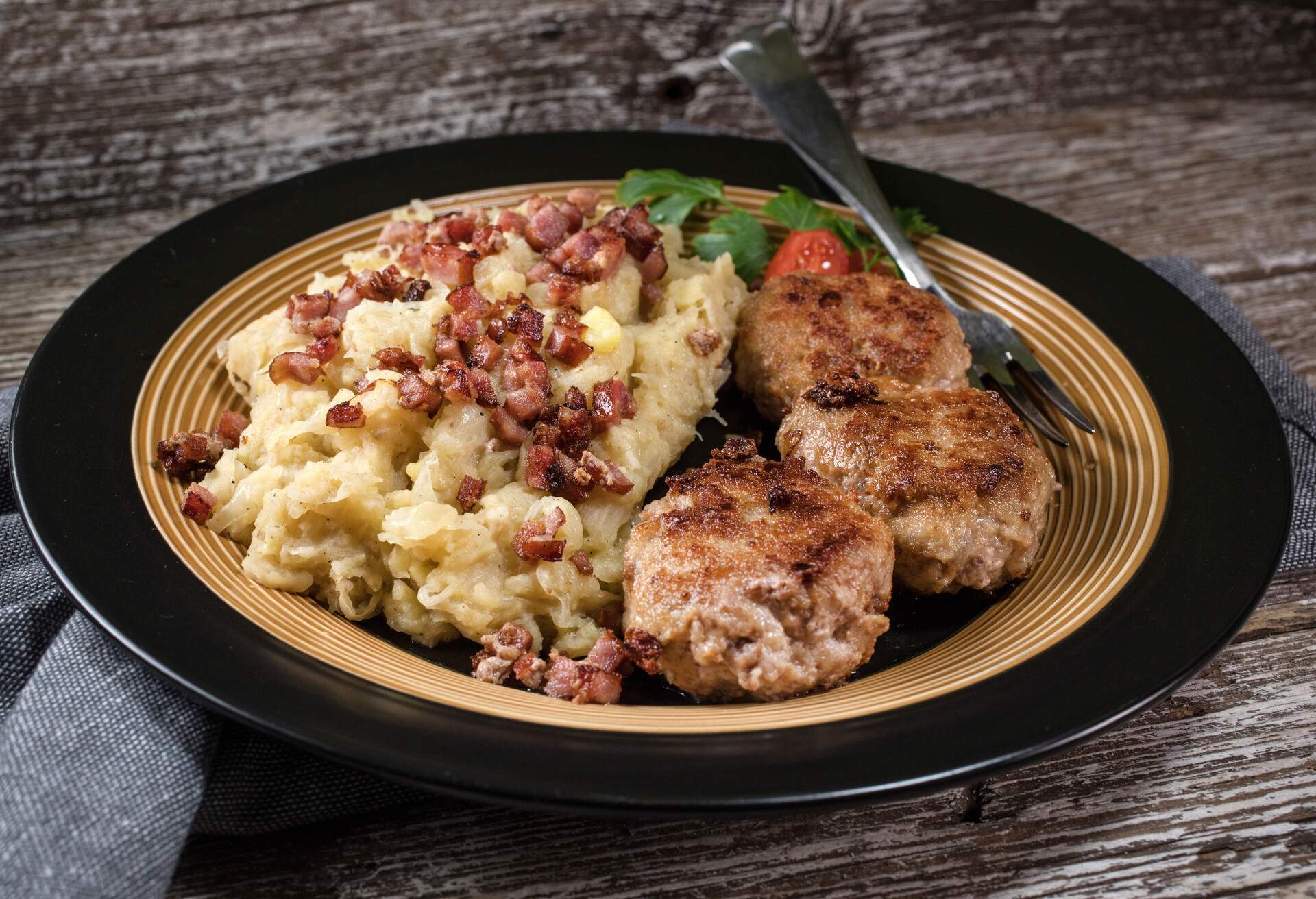
Another famous Polish food that takes influences from a country not too far away is kotlet mielony. Similar to Danish meatballs, Polish kotlet mielony, is made with minced pork bound with eggs and breadcrumbs and flattened before frying to a crispy, tasty morsel that’s then served with either boiled potatoes or sauerkraut or pickled beetroot in the summer months. Are your tastebuds tingling yet? You will, of course, find many variations of this popular Polish food sometimes going by names such as sznycle or karminadle if you are in Silesia.
Kaszanka
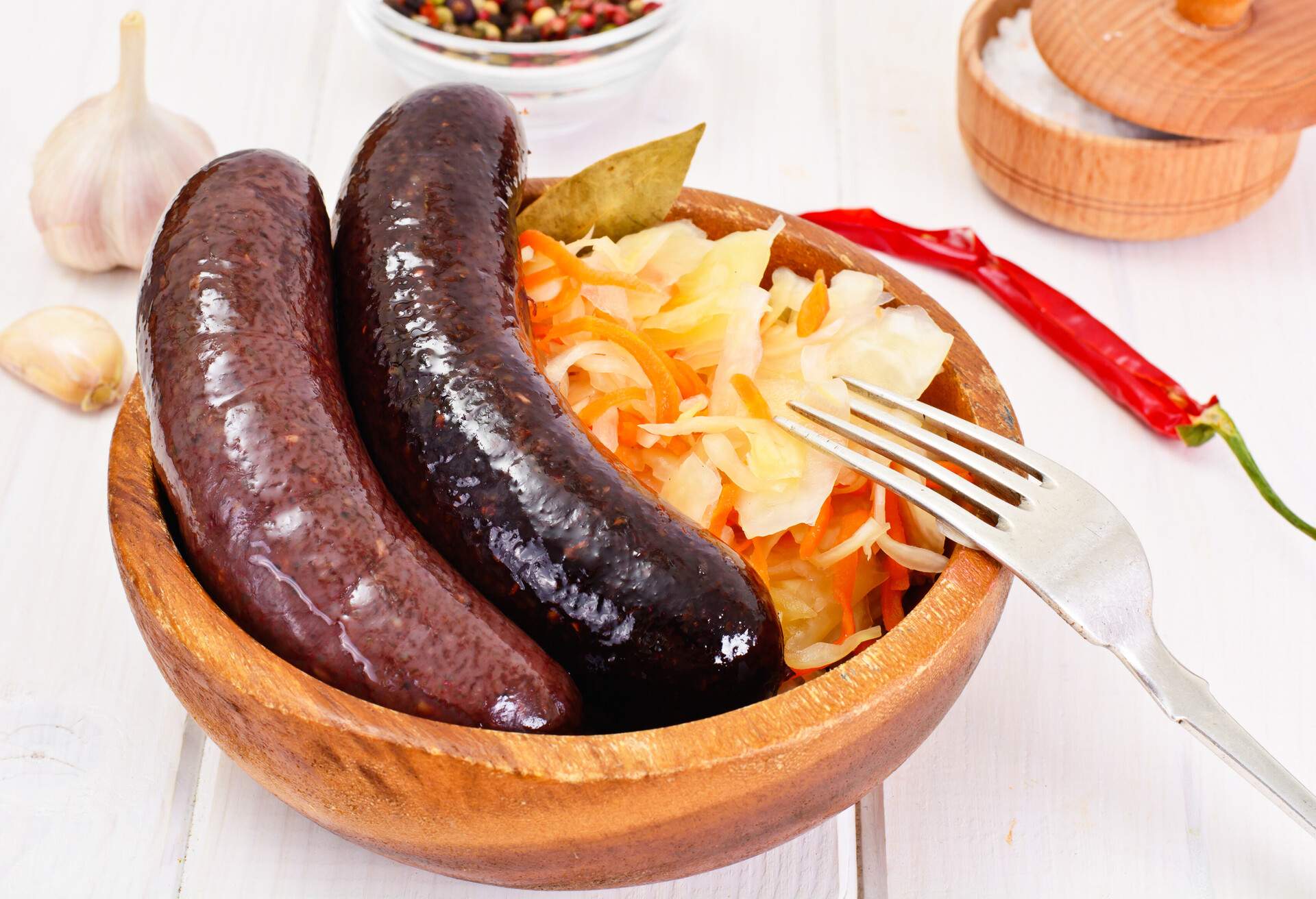
The use of blood is very much a part of traditional Polish cuisine. A good example of a popular Polish food that uses it in its cooking is the utterly delicious kaszanka sausage. Made with pig blood, pork offal, fat, liver and buckwheat stuffed into a pork intestine with onions and spices such as marjoram, it’s one of the must-try Polish delicacies. It will often be either fried, boiled or baked and served with, yes, a side of potatoes or sauerkraut. To have a truly authentic experience of this dish, why not head to Zakopane, a buckwheat-producing region of the country where you will find many street-food stands selling it?
Placki Ziemniaczane
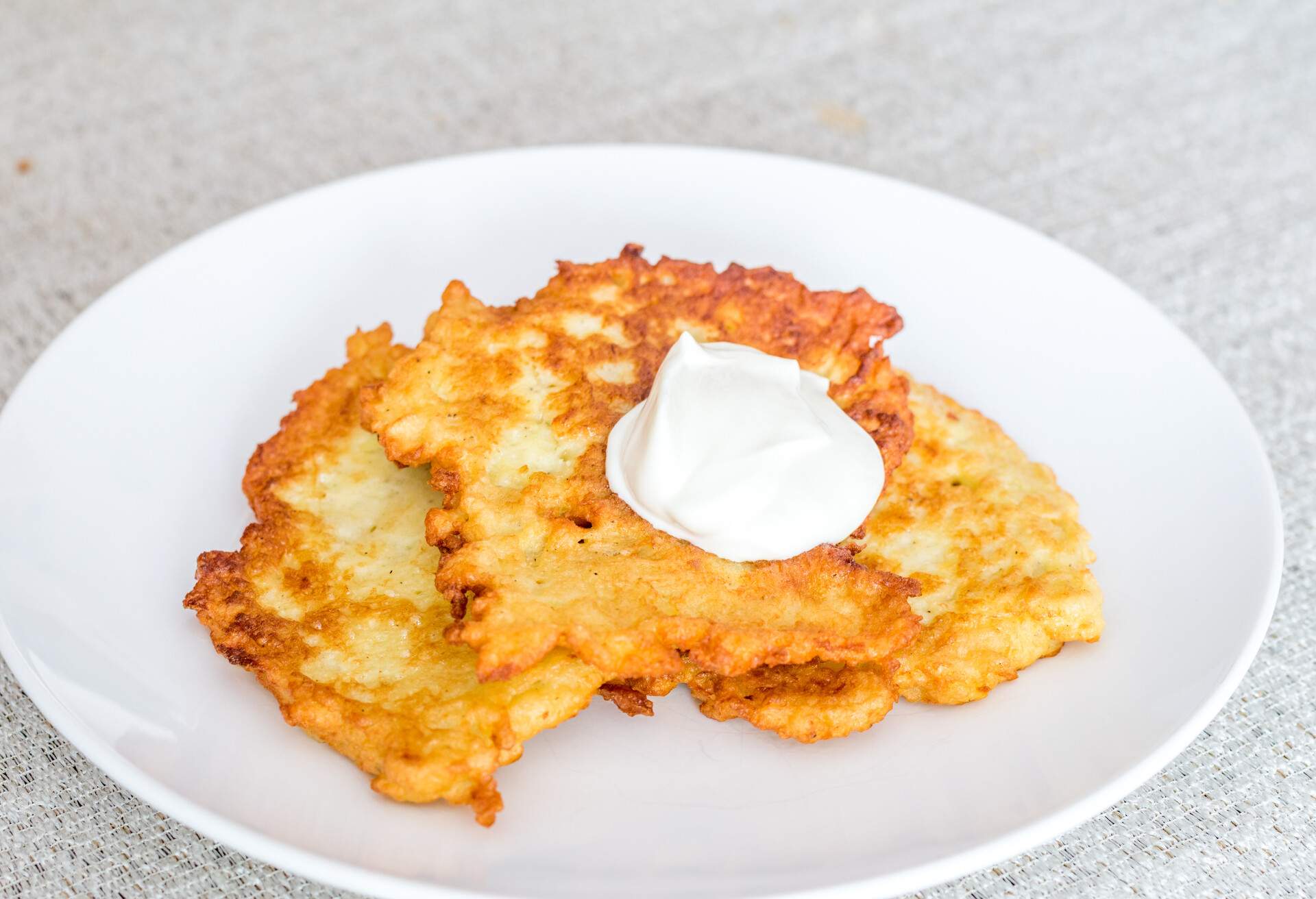
It goes without saying that potatoes, in every form, are very much a part of traditional Polish dishes. A dish that elevates the humble potato to different levels is placki ziemniaczane, a potato pancake. Made with grated potatoes mixed with flour and egg for binding, you will get versions using apple sauce, before pan frying. It’s a crispy morsel of deliciousness worth crunching on its own as a snack. Used to replace bread when there were shortages in tough economic times, it’s a typical Polish food that accompanies many meals. You’ll often find it served with a topping of meat sauce, sour cream or goulash (another famous Polish stew).
Silesian Kluski
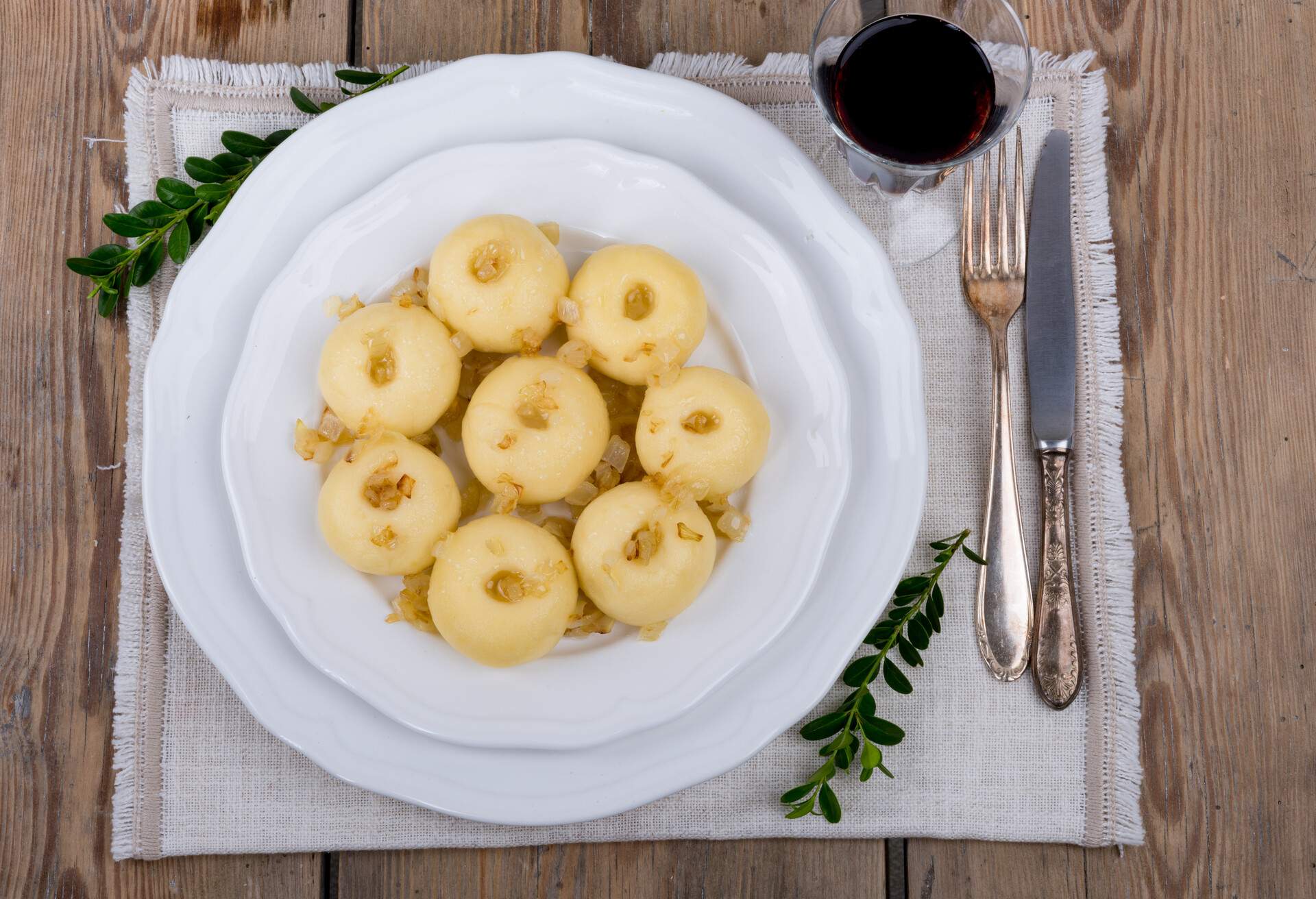
If you are in Silesia, potatoes come in the form of the Silesian kluski, a dimpled potato dumpling, all the better to capture whatever sauce you’re having yours with. Polish food and drink often go together, so here it’s enjoyed with a glass or two of beer. Head to Katowice, the capital, and Browar Mariacki, where you can enjoy the two together. This brewery in the heart of the city has a trendy restaurant where you can enjoy many of its various brews with typical Polish dishes.
Flaki
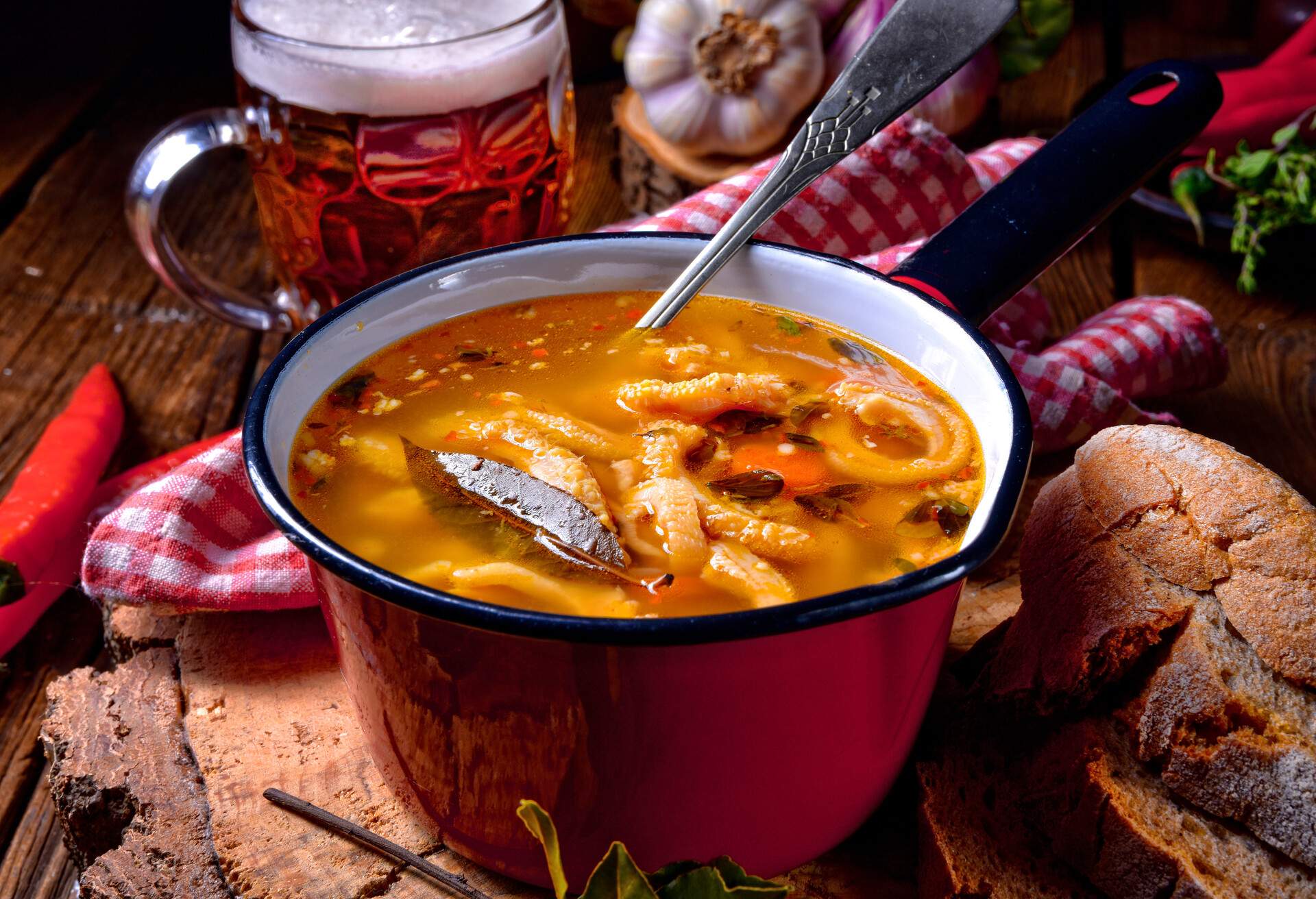
When it comes to stews, Polish traditional foods have the obvious, like goulash, as well as the less obvious. Let not the thought of a tripe stew put you off; flaki is a must-try Polish delicacy. Made with beef tripe, the dish became popular during the days of Poland’s King Jogelia, who utterly enjoyed it. Dating as far back as the 14th century, it offers us a glimpse into the evolution of Polish cuisine. As times have evolved, so has the dish. In Warsaw, head to the Old Town neighbourhood of Praga, where you will find the cosy Pyzy Flaki Gorace; it offers its version and lots of other Polish national foods to try.
Bigos
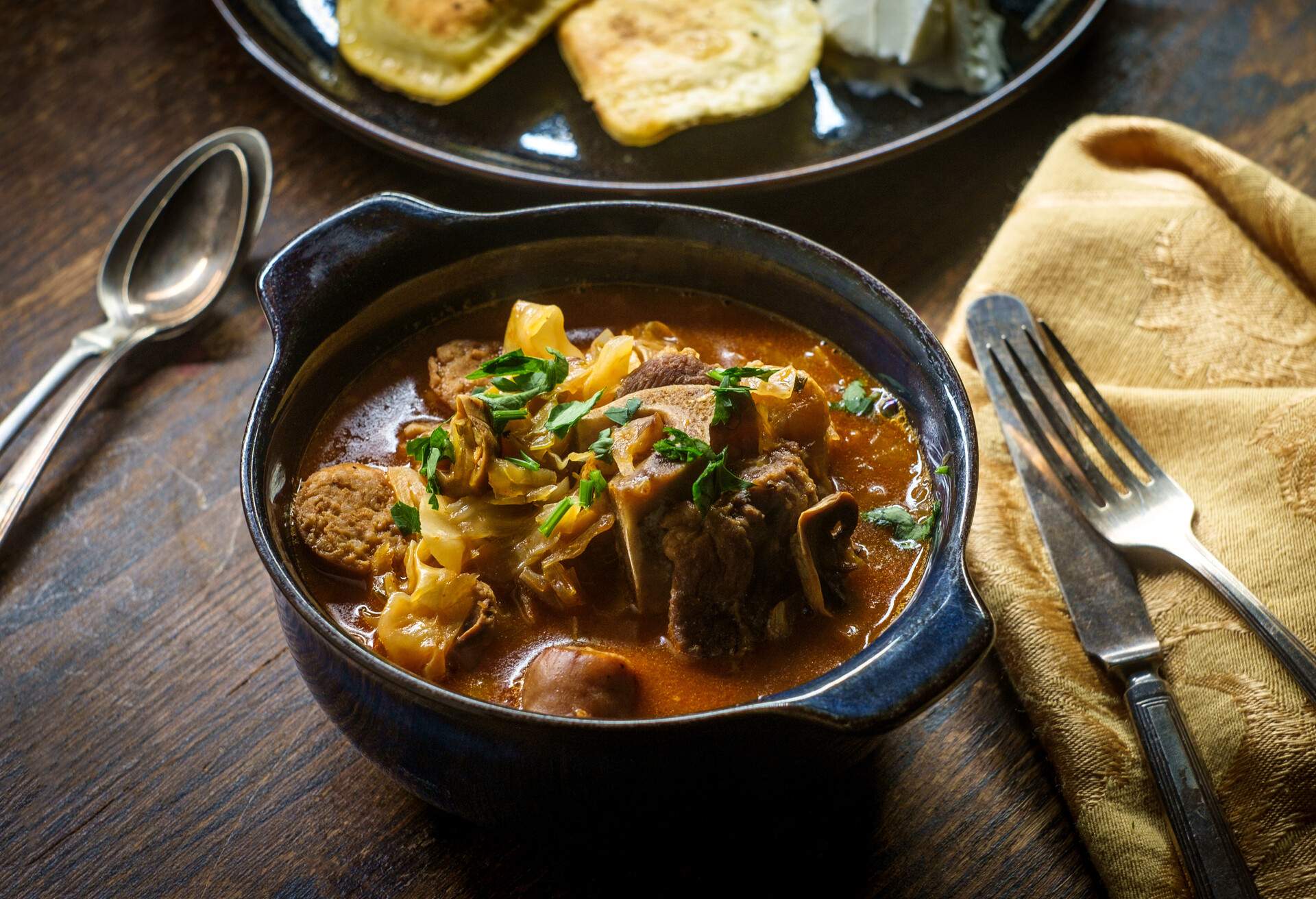
Now if there’s a dish that celebrates Polish traditional cuisine, bigos is it. A popular dish with the nobility in the 17th and 18th centuries, it’s what they carried on their hunting expeditions. It has long evolved from a dish that used chicken, even fish, with pickled fruits, to the popular versions commonly eaten on special occasions today. Quite easily Poland’s national dish, it’s some form of hunter’s stew that celebrates Poland’s love of sauerkraut and meat, often beef or pork but sometimes game too. All these ingredients are combined in a pot with the addition of shredded cabbage, sausages and a variety of veggies simmered over hours, leaving a hearty and delicious stew.
For a truly special experience, head to the picturesque town of Wroclaw, on the River Ode in western Poland. Here, together with a trained chef, you can decide exactly what you’d like in yours at Stol na Szwedzkiej.
Polish Sweets

We can’t talk about traditional Polish food without a mention of its sweets, of which there are plenty. From the iconic sekacz, made with a thick batter poured over a rotating spit in an oven or open fire, to szarlotka, a Polish apple pie. They are morish, indulgent and often regional and will leave you wanting to go back for more. These are just some of the most popular must-try options.
Racuchy
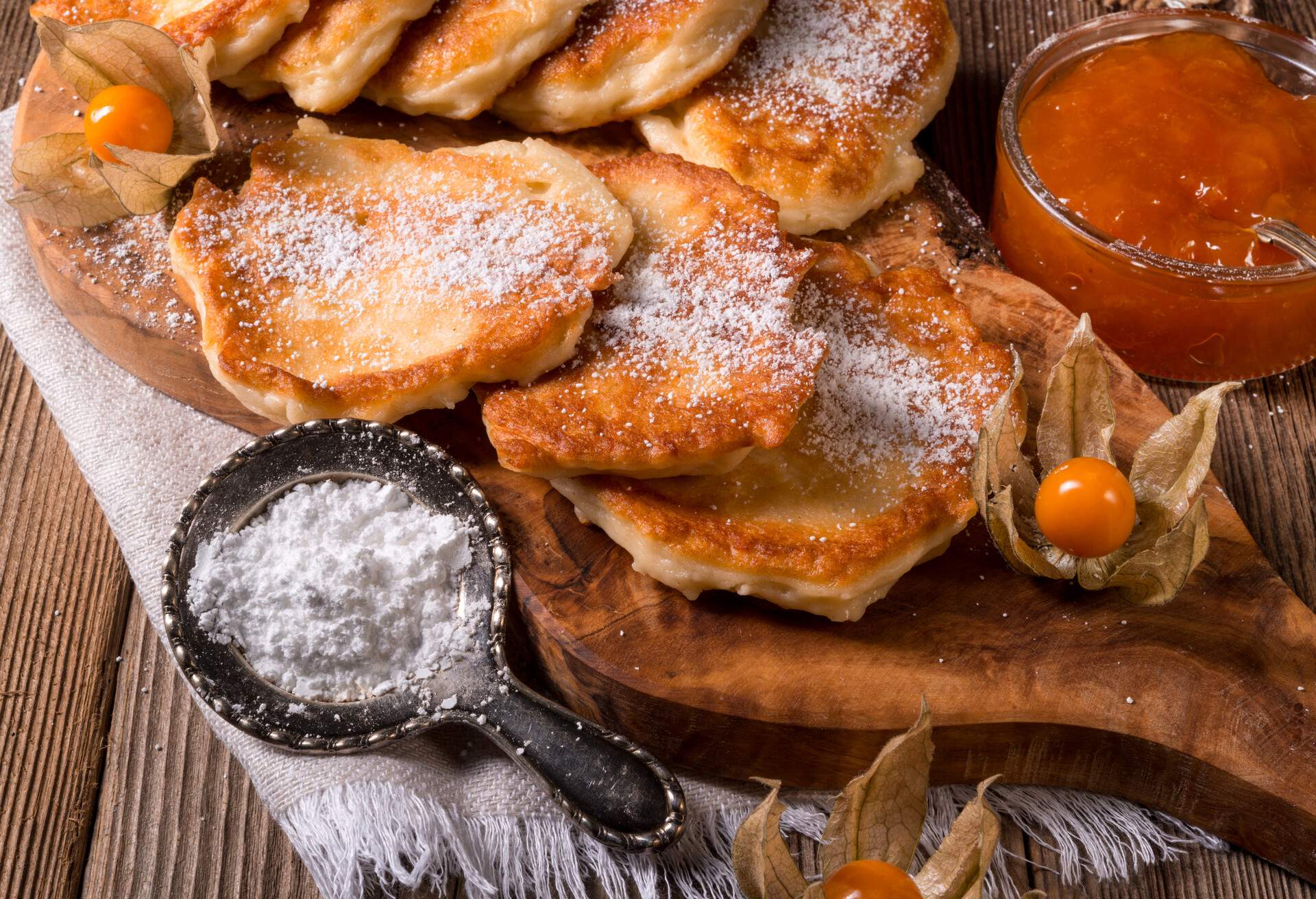
As pancakes are loved worldwide, there is no better place to start. The Polish version is known as racuchy. Made with a batter of flour, milk, eggs, sugar and salt that’s pan-fried, they are fluffy morsels coated by tasty crispiness. Served as a dessert, as you will find at Zurownia in Silesia, which also serves other Silesian dishes to try out. Savoury versions are common at Christmas and form an integral part of the celebrations.
Makowiec
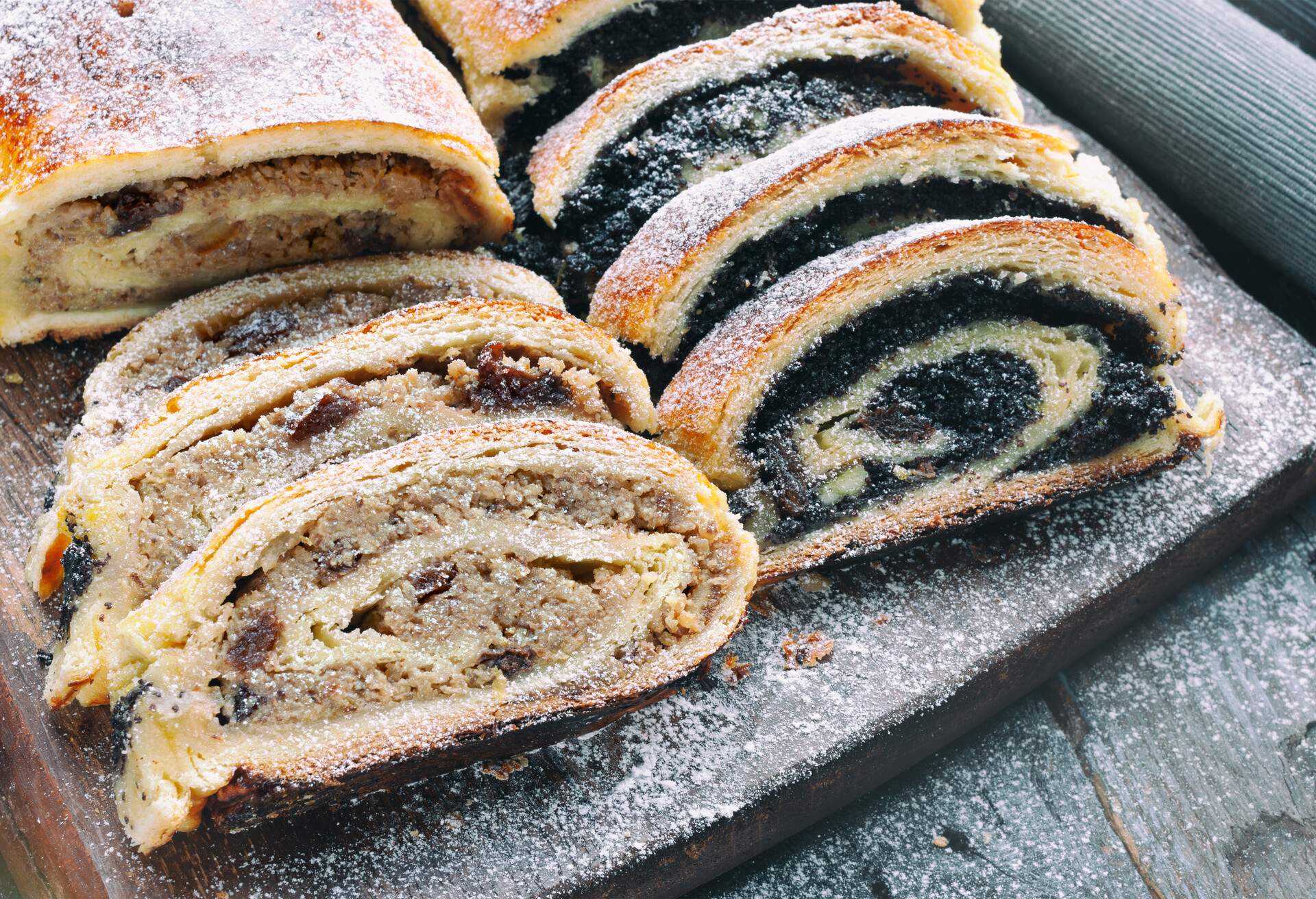
Probably one of Poland’s most famous and popular sweets is makowiec. Commonly made during the holiday season, it’s a form of Swiss roll with a poppyseed paste filling. Other fillings, more commonly found during the festive period, include minced walnuts and chestnuts. Try it at Odette Tea Room in Warsaw with an assortment of teas on offer. Otherwise, head to Market Square in the Old Town to enjoy it with a dose of people-watching with your cup of coffee.
Faworki
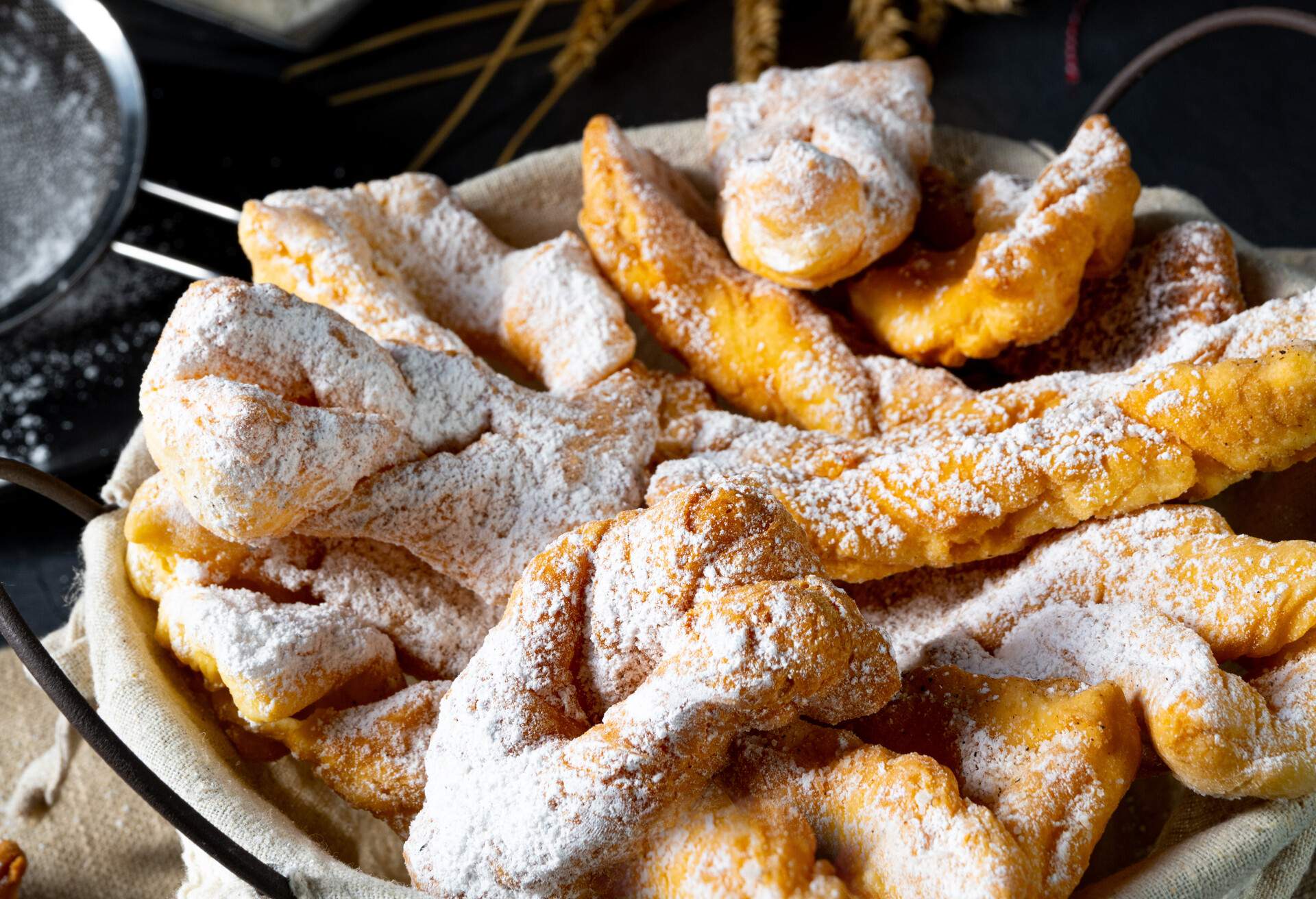
Given their name, faworki (or angel wings) are common in Poland during the festive seasons. Traditionally, they were served just before lent began. They sometimes go by the name chrusciki, perhaps due to their brittleness. Other more romantic stories link them to the colourful ribbons medieval knights attached to their armoury, gifts given to them by their female lovers or admirers.
Either way, they are made from a wheat, sour cream and egg yolk pastry that’s twisted and then deep-fried to leave it light and brittle before being sprinkled with icing sugar; light, crispy deliciousness that’s hard to resist. Their origin may stem from the Romans, whose early empire stretched throughout Europe and as a result, you will find variations of them in Italy and Hungary, amongst a few others.
Mazurek
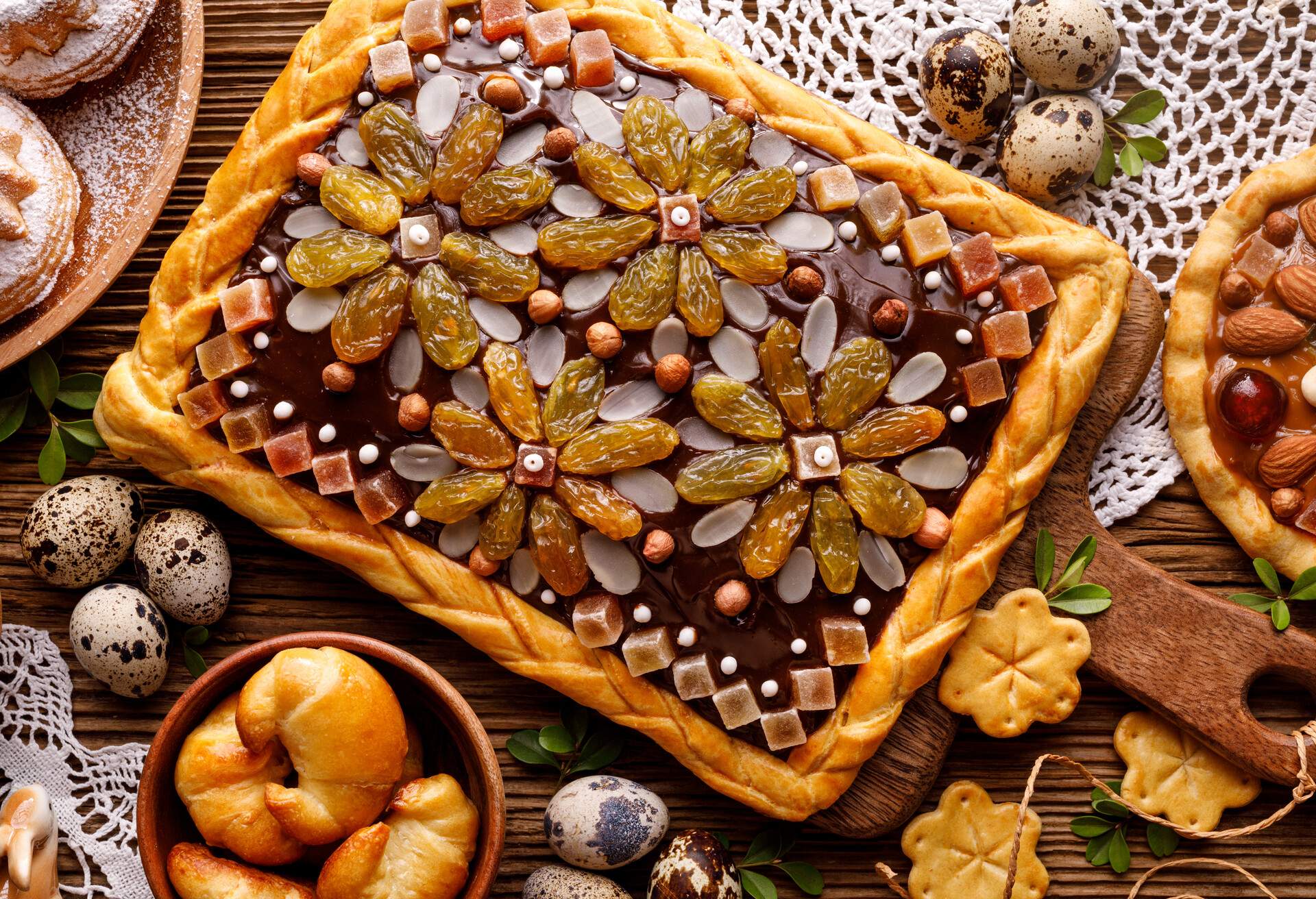
Yet another sweet associated with celebrations, mainly Easter, is mazurek. A thin cake, sometimes with two layers, it comes in many different forms, including glazed and decorated marzipan. Perhaps the most common is that of a sponge made with twarog (a cottage cheese-like substance), egg yolks, raisins and nuts that are then baked before decorating. Toppings include dried fruit, meringues or nuts. It’s both chewy and crispy and, yes, delightful to devour.
Kremowka
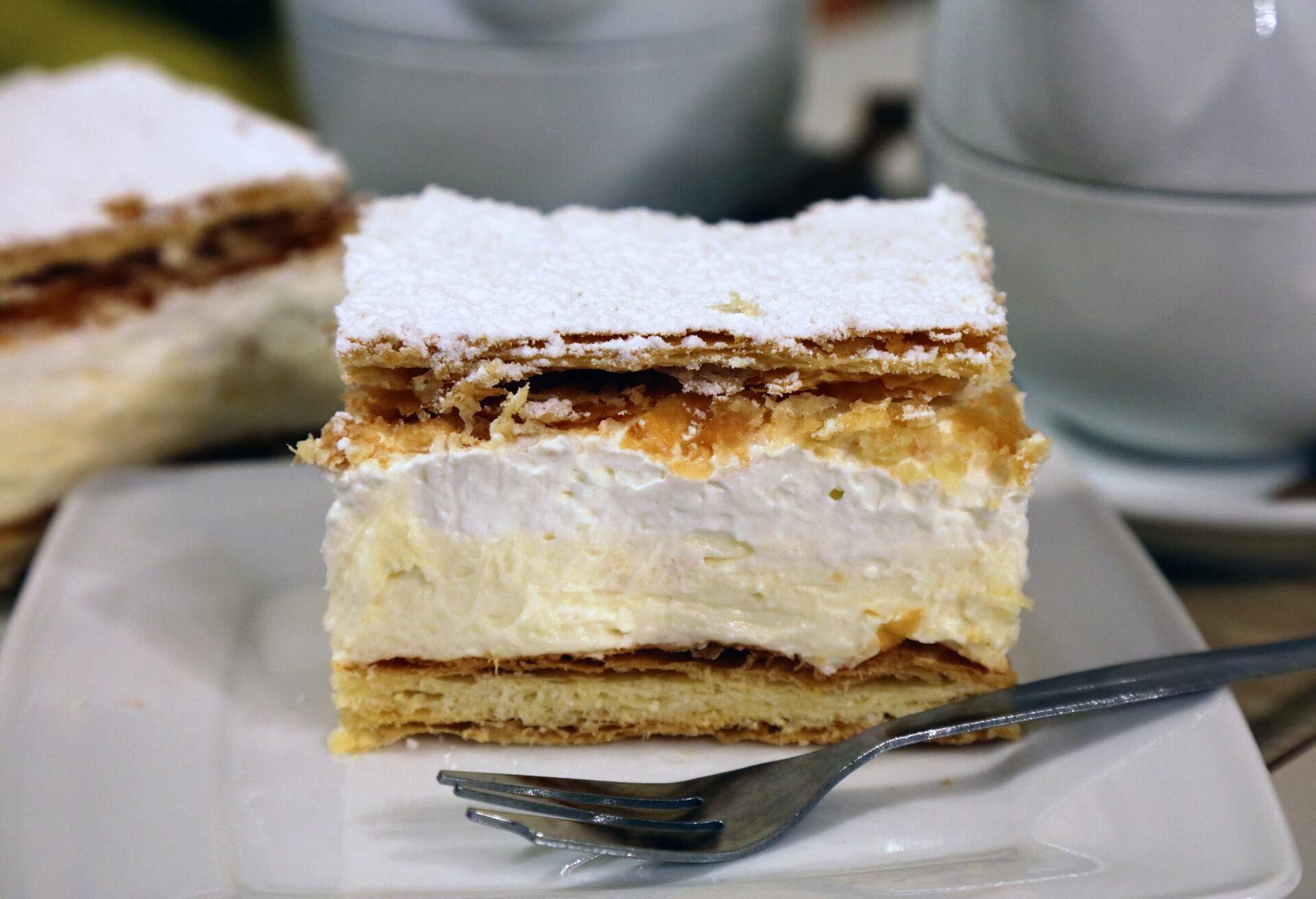
The masters of Viennoiseries have also lent their craft to Polish traditional foods, this time in the form of the elegant and utterly enjoyable kremowka. This is Poland’s answer to the French mille-feuille, thin crispy baked layers of pastry enveloping a delicious filling. In Poland, it’s filled with a soft meringue made from a sweetened cream whipped with egg whites.
A heavenly cloud encased in crispiness, which left Pope John Paul II hungering for home after he left Poland for the Vatican. They were his favourite dessert. Every decent pastry shop in Warsaw boasts some version of it.
Kolocz Slaski
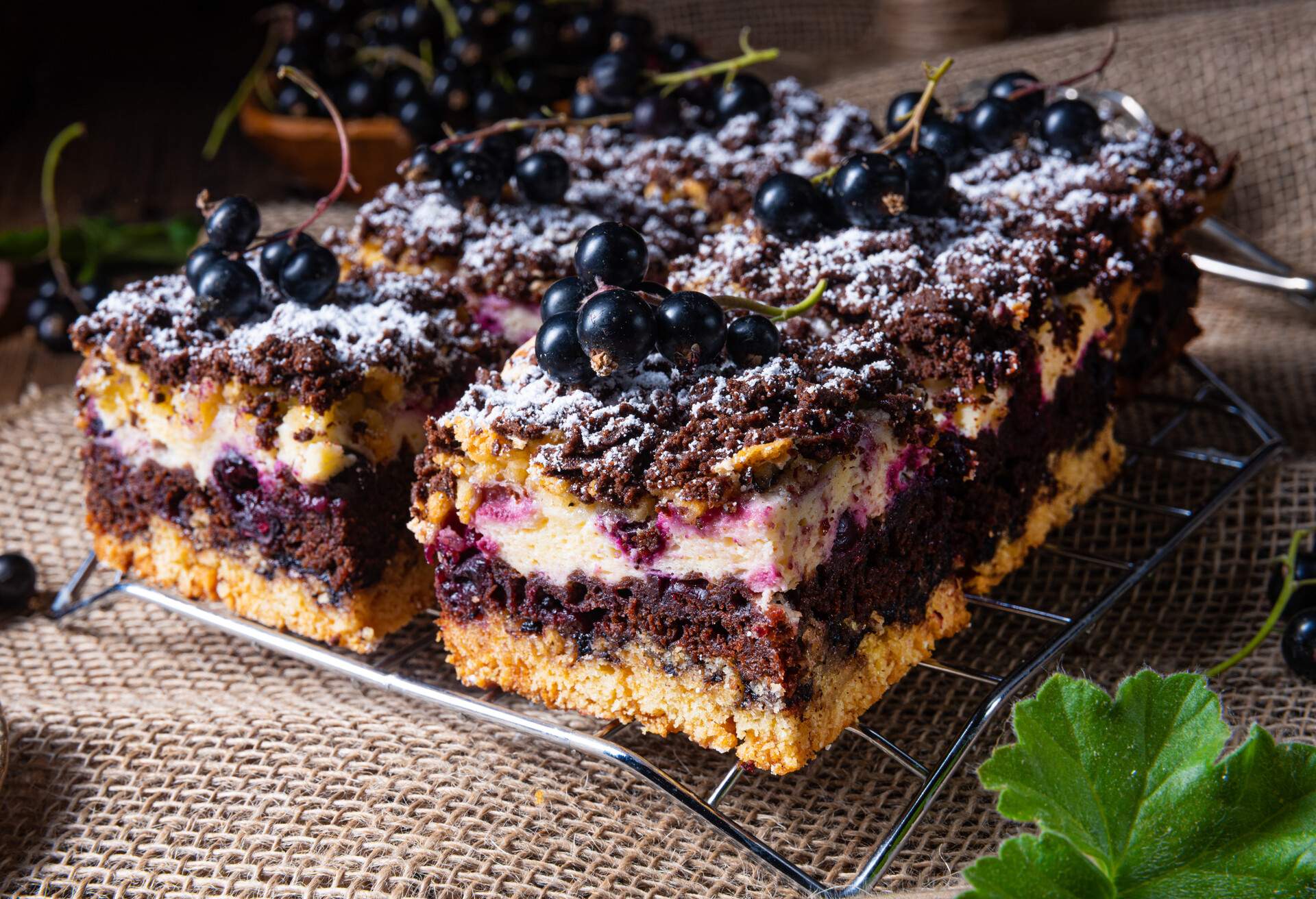
We will end our food extravaganza of traditional Polish food with a cake that has played and still plays a big role in the Polish way of life, the kolocz slaski. Commonly found in the Silesian region, it dates as far back as the 10th century, when it was exclusively made by specially skilled women. These women guarded the process of making it so tightly that no men were allowed into the room in which it was made. This cake, with a crumbly topping, has so much meaning to the Polish people and is often gifted to newlyweds before their nuptials, to bless them with a family.
Golden on the outside and topped with icing sugar, the fillings range from apple and poppyseed to cheese.
If you are curious about Italy and its diverse food culture, then read this article on Italian food traditions. Whereas, if it’s Germany you are interested in, our article on traditional food in Germany is what to check out. Malta has some enticing cuisines too, and our Malta food guide lays it all out. When planning a trip to Dubai, find out about its food scene and where to go with this guide uncovering the food of Dubai; it should be your go-to checklist.
